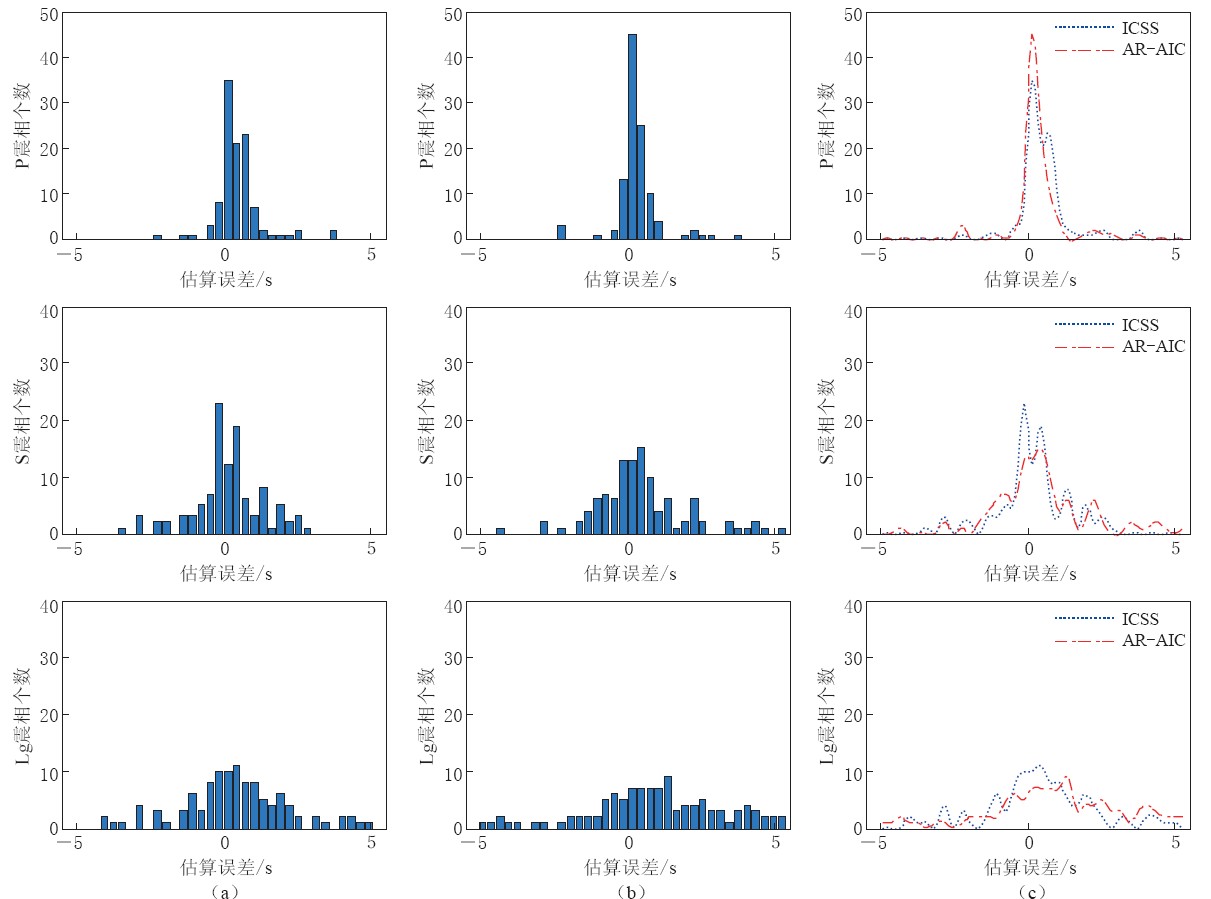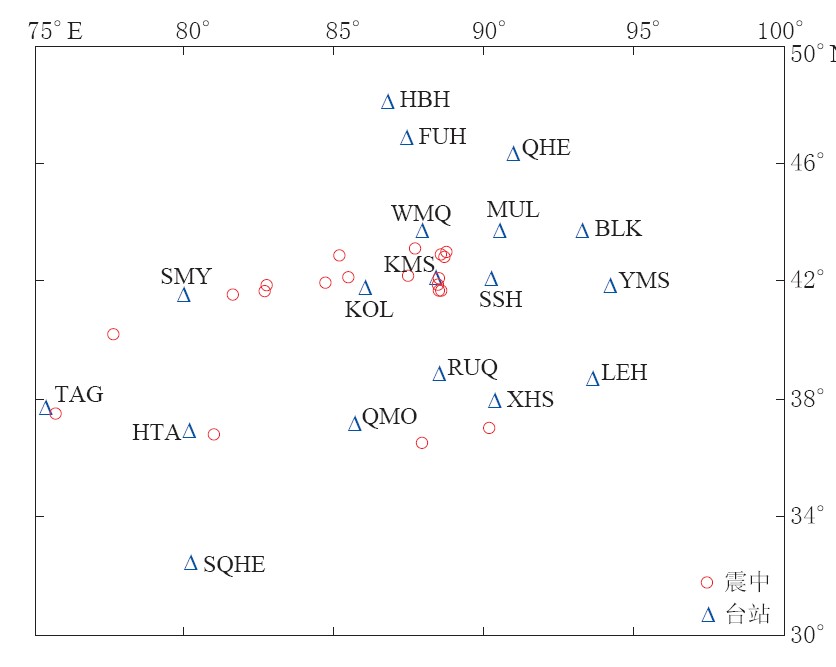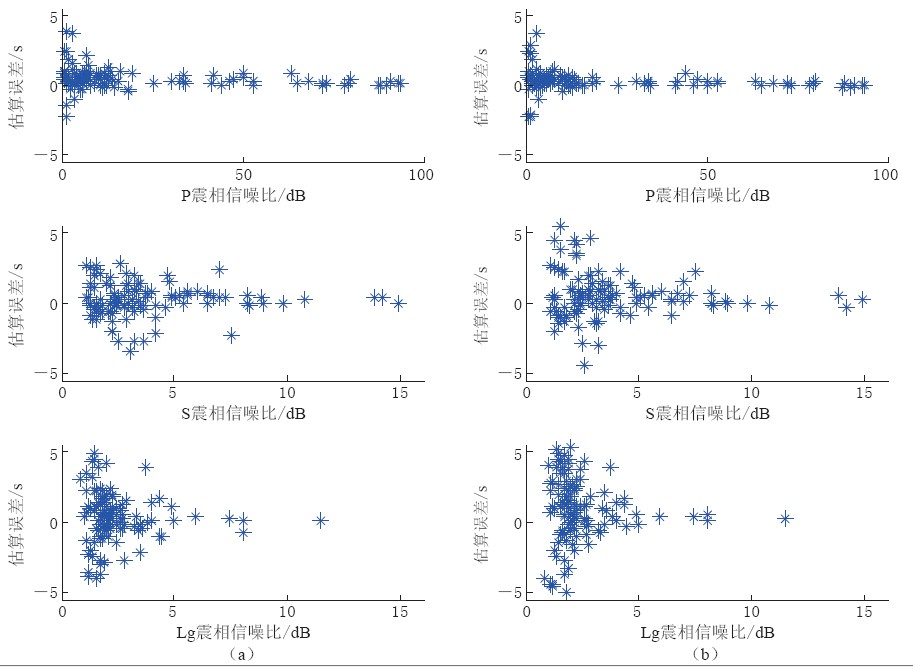A comparative study between ICSS and AR-AIC algorithms on onset time estimation for seismic signals
-
摘要: 介绍了不同于自回归赤池准则算法(AR-AIC)的另外一种到时估算方法累积和法(CUSUM). 作为一种序贯分析方法, 累积和法主要用于满足一定噪声假设且相对稳定的数据序列中, 用以检测其发生异常改变的信号到时位置. 其中重点介绍了改进后的累积和算法迭代累积平方和算法(ICSS)的基本原理及其在区域震到时估算方面的应用实例, 并将其与AR-AIC算法的到时估算结果进行了比较分析. 分析结果表明, 相对于AR-AIC算法, ICSS算法在对区域震S波和Lg波的到时估算方面具有估算误差小、 计算时间短的优势, 具有一定的应用价值.Abstract: This paper introduces another onset time estimation method, cumulative sum algorithm (CUSUM for short), which is different from AR-AIC algorithm. As a sequential analysis method, CUSUM is mainly used to detect the onset time of anomalous signals with the assumption that background noises are quasi-stationary. This paper mainly introduces the improved CUSUM method,iterative cumulative sums of squares algorithm (ICSS for short) and its application to onset time estimation for regional seismic signals. The results indicate that, in comparison with AR-AIC algorithm, ICSS algorithm has a certain advantage of minor error in estimating onset times of regional S and Lg waves, and it takes less time to compute than AR-AIC algorithm.
-
Keywords:
- seismic signal /
- cumulative sum /
- onset time estimation /
- timeliness comparison
-
-
图 1 某区域震记录及ICSS算法到时估算结果
(a) 原始地震信号波形; (b) 滤波后的地震信号波形; (c) 经1次迭代后的ICSS曲线; (d) 经2次 迭代后的ICSS曲线; (e) 经3次迭代后的ICSS曲线; (f) 经4次迭代后的ICSS曲线
Figure 1. A regional earthquake record and onset time estimation results by ICSS
(a) Original seismic waveform; (b) Filtered seismic waveform; (c) ICSS curve after the first iteration; (d) ICSS curve after the second iteration; (e) ICSS curve after the third iteration; (f) ICSS curve after the fourth iteration
图 2 改变估算条件后的某区域震记录及ICSS算法到时估算结果
(a) 滤波后的地震信号波形; (b) 经1次迭代后的ICSS曲线; (c) 经2次迭代后的ICSS曲线; (d) 经3次迭代后的ICSS曲线; (e) 经4次迭代后的ICSS曲线; (f) 经5次迭代后的ICSS曲线
Figure 2. A regional earthquake record and onset time estimation results by ICSS after the estimation conditions are modified
(a) Filtered seismic waveform; (b) ICSS curve after the first iteration; (c) ICSS curve after the second iteration; (d) ICSS curve after the third iteration; (e) ICSS curve after the fourth iteration; (f) ICSS curve after the fifth iteration
图 4 结合地震信号自动处理方法后的ICSS算法到时估算结果
(a) 原始地震信号波形; (b) P波估算的ICSS曲线; (c) S波估算的ICSS曲线; (d) Lg波估算的ICSS曲线
Figure 4. The onset time estimation results by ICSS combined with automatic seismic signal processing method
(a) Original seismic waveform; (b) ICSS curve of P wave onset time estimation; (c) ICSS curve of S wave onset time estimation; (d) ICSS curve of Lg wave onset time estimation
表 1 (a) Original seismic waveform; (b) ICSS curve of P wave onset time estimation; (c) ICSS curve of S wave onset time estimation; (d) ICSS curve of Lg wave onset time estimation
Table 1 Statistic results of the errors in onset time estimation using ICSS and AR-AIC methods

-
刘希强, 周彦文, 曲均浩, 石玉燕, 李铂. 2009. 应用单台垂向记录进行区域地震事件实时检测和直达P波初动自动识别[J]. 地震学报, 31(3): 260-271. Liu X Q, Zhou Y W, Qu J H, Shi Y Y, Li B. 2009. Real-time detection of regional events and automatic P-phase identification from the vertical component of a single station record[J]. Acta Seismologica Sinica, 31(3): 260-271 (in Chinese).
唐明帅, 王海涛. 2011. F检测算法及其在识别地震地表反射波震相中的初步应用[J]. 地震学报, 33(6): 776-787. Tang M S, Wang H T. 2011. F-detection algorithm and its preliminary application to seismic surface reflected wave phase identification[J]. Acta Seismologica Sinica, 33(6): 776-787 (in Chinese).
王海军, 靳平, 刘贵忠. 2003. 低信噪比地震记录中信号初至的估计[J]. 西安交通大学学报, 37(6): 659-660. Wang H J, Jin P, Liu G Z. 2003. Onset estimation for signals with low signal to noise ratio[J]. Journal of Xi'an Jiao tong University, 37(6): 659-660 (in Chinese).
王继, 陈九辉, 刘启元, 李顺成, 郭飚. 2006. 流动地震台阵观测初至震相的自动检测[J]. 地震学报, 28(1): 42-51. Wang J, Chen J H, Liu Q Y, Li S C, Guo B. 2006. Automatic onset phase picking for portable seismic array observation[J]. Acta Seismologica Sinica, 28(1): 42-51 (in Chinese).
杨配新, 邓存华, 刘希强, 任勇, 颜其中. 2004. 数字化地震记录震相自动识别的方法研究[J]. 地震研究, 27(4): 308-313. Yang P X, Deng C H, Liu X Q, Ren Y, Yan Q Z. 2004. Studies on auto-distinguishing phase of digital seismic recordings[J]. Journal of Seismological Research, 27(4): 308-313 (in Chinese).
张诚鎏. 2010. 地震信号识别和关联技术研究[D]. 西安: 西北核技术研究所: 10-15. Zhang C L. 2010. Study on seismic phases identification and association[D]. Xi'an: Northwest Institute of Nuclear Technology: 10-15 (in Chinese).
Akaike H. 1973. Information theory and an extension of the maximum likelihood principle[C]//Petrov B N, Csaki F eds. International Symposium on Information Theory. Budapest: Akademiai Kiado: 267-281.
Allen R V. 1978. Automatic earthquake recognition and timing from single trace[J]. Bull Seismol Soc Am, 68(5): 1521-1532.
Allen R V. 1982. Automatic phase pickers: Their present use and future prospects[J]. Bull Seismol Soc Am, 72(6B): 225-242.
Blandford R R. 1974. An automatic event detector at the Tonto Forest seismic observatory[J]. Geophysics, 39(5): 633-643.
Der Z A, Shumway R H, McGarvey M W. 1998. Automatic interpretation of regional seismic signals using the CUSUM-SA algorithms[G]//21st Seismic Research Symposium. Davis: University of California: 393-403.
Der Z A, Shumway R H. 1999. Phase onset time estimation at regional distances using the CUSUM algorithm[J]. Phys Earth Planet Inter, 113(1/2/3/4): 227-246.
Gentili S, Bragato P. 2006. A neural-tree-based system for automatic location of earthquakes in Northeastern Italy[J]. Seismology, 10(1): 73-89.
Gibbons S J, Frode R. 2006. The detection of low magnitude seismic events using array-based waveform correlation[J]. Geophys J Int, 165(1): 149-166.
Hildyard M W, Nippress S E J, Rietbrok A. 2008. Event detection and phase picking using a time-domain estimate of predominate period Tpd[J]. Bull Seismol Soc Am, 98(6): 3025-3032.
Inclán C, Tiao G C. 1994. Use of cumulative sums of squares for retrospective detection of changes of variance[J]. Journal of the American Statistical Association, 89(427): 913-923.
Kedrov O K, Ovtchinnikov V M. 1990. An online analysis system for three-component seismic data: Method and preliminary results[J]. Bull Seismol Soc Am, 80(6): 2053-2071.
Küperkoch L, Meier T, Diehl T. 2012. Chapter 16: Automated event and phase identification[G]//Bormann P ed. New Manual of Seismological Observatory Practice 2 (NMSOP-2). Potsdam: IASPEI, GFZ German Research Centre for Geosciences: 23-30.
Leonard M, Kennett B L N. 1999. Multi-component autoregressive techniques for the analysis of seismograms[J]. Phys Earth Planet Inter, 113(1/2/3/4): 247-263.
Longbottom J, Walden A T, White R E. 1988. Principles and application of maximum kurtosis phase estimation[J]. Geo-physical Prospecting, 36(2): 115-138.
Maeda N. 1985. A method for reading and checking phase times in autoprocessing system of seismic data[J]. Zisin, 38(3): 365-379.
Melton R S, Bailey L F. 1957. Multi signal correlators [J]. Gepphysics, 22(3): 565-588.
Sleeman R, van Eck T. 1999. Robust automatic P-phase picking: An on-line implementation in the analysis of broadband seismogram recordings[J]. Phys Earth Planet Inter, 113(1/2/3/4): 265-275.
Stevenson R. 1976. Microearthquakes at Flathead Lake, Montana: A study using automatic earthquake processing[J]. Bull Seismol Soc Am, 66(1): 61-79.
Wang J, Teng T. 1997. Identification and picking of S phase using an artificial neural network[J]. Bull Seismol Soc Am, 87(5): 1140-1149.
Zhang H, Clifford T. 2003. Automatic P-wave arrival detection and picking with multiscale wavelet analysis for single component recordings[J]. Bull Seismol Soc Am, 93(5): 1904-1912.
Zhao Y, Kiyoshi T. 1999. An artificial neural network approach for broadband seismic phase picking[J]. Bull Seismol Soc Am, 89(3): 670-680.
-
期刊类型引用(13)
1. 颜心园,卢元刚,王琳. 行波效应下大跨度多塔斜拉桥随机地震响应研究. 工程与建设. 2021(06): 1287-1289 .  百度学术
百度学术
2. 黎璟,杨华平,钱永久,龚婉婷. 非一致激励下大跨度铁路斜拉桥地震响应规律. 铁道建筑. 2019(06): 14-16+32 .  百度学术
百度学术
3. 林家浩,张亚辉,赵岩. 虚拟激励法在国内外工程界的应用回顾与展望. 应用数学和力学. 2017(01): 1-32 .  百度学术
百度学术
4. 阮锦发. 全漂浮体系双塔混凝土斜拉桥地震响应分析. 福建建设科技. 2016(06): 19-23 .  百度学术
百度学术
5. 杨吉新,马璐珂,高辉,黎建华,刘佩. CFRP索斜拉桥地震波行波效应分析. 工程与建设. 2016(05): 649-653 .  百度学术
百度学术
6. 张凡,颜晓伟,李帅,王景全. 考虑波速影响的斜拉桥非一致激励地震响应研究. 建筑科学与工程学报. 2016(04): 60-68 .  百度学术
百度学术
7. 黄学漾,宗周红,夏坚,黎雅乐,夏樟华. 强震作用下独塔斜拉桥模型的非线性动力响应分析. 东南大学学报(自然科学版). 2015(02): 354-359 .  百度学术
百度学术
8. 李伟立,余报楚. 行波效应在桥梁抗震性能分析中的应用. 淮海工学院学报(自然科学版). 2015(03): 68-71 .  百度学术
百度学术
9. 孙才志,赵雷,王菲. 大跨度多塔斜拉桥随机地震响应分析. 地震工程学报. 2014(04): 911-918 .  百度学术
百度学术
10. 许莉,郑旭霞. 非一致地震激励下大跨斜拉桥的地震反应. 福州大学学报(自然科学版). 2013(04): 528-533 .  百度学术
百度学术
11. 方诗圣,康小方,王建国,王伟. 行波效应对大跨度斜拉桥地震反应的影响. 桥梁建设. 2013(01): 23-29 .  百度学术
百度学术
12. 宋刚,汪飞澜. 多点演变随机激励下连续刚构桥地震响应. 土木工程学报. 2013(S2): 249-254 .  百度学术
百度学术
13. 宋刚,梁伟业. 行波激励下斜交拱桥地震响应分析. 中国高新技术企业. 2012(13): 13-15 .  百度学术
百度学术
其他类型引用(23)





 下载:
下载:






